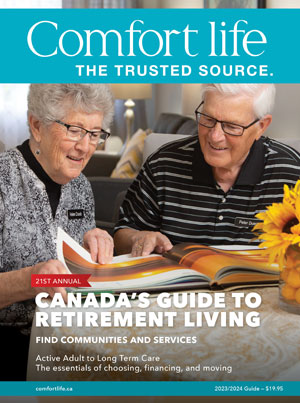What to know about this topic:
- What assistance is covered by OHIP?
- What services are available through private care?
- Comparing assisted living to home care
- Where seniors and families should start
Over 90% of seniors want to remain in their homes for as long as possible, according to a survey by Home Care Ontario. This fits with most seniors’ ideals in terms of independence, comfort, and a need for community and familiarity, even as they adapt to changing health and safety needs.
Many will require some type of support to make that wish a reality, though.
Aging at home becomes a greater challenge if they must stop driving, when stairs become difficult, or when cognitive or physical decline hinders their ability to manage a household. Plan as soon as you can, considering family support, community-based healthcare, and a private home care service like In-home Assisted Living Inc.
Find out about home care services from In-home Assisted Living, Inc.
“The most common hurdle is getting started,” says Steve Jones, President of In-home Assisted Living. “That hinges on mom and dad acknowledging that they’re vulnerable or that they require assistance. Then they need to accept help.” Unfortunately, too many seniors wait until a health crisis or the loss of a loved one before accepting help.
When you’re researching care needs, there are four basic questions you need to deal with.
What assistance is covered by OHIP?
In Ontario, there is free basic government home care service provided by an organization called Home and Community Care Support Services (HCCSS). This service is covered by our healthcare system and is available to anyone with a health card. HCCSS is free for seniors, people with disabilities, injuries, and illnesses to get assistance with Activities of Daily Living (ADLs). ADLs include tasks like personal hygiene, toileting, dressing, bathing, and feeding.
While these personal care services are critical to our healthcare continuum of hospital-to-home or to help reduce the frequency of rehospitalization, service is typically limited to three, seven, or fourteen short visits per week depending upon the severity of the patient’s condition.
It’s part of our Healthcare system, so it’s limited in scope and does not include safety supervision, housekeeping, meal preparation, medication management, household management, companionship, or escort services to appointments. There’s also not much flexibility in scheduling. For those things, you need a private homecare service like In-home Assisted Living Inc.
What services are available through private care?
Jones says many families receiving private home care services are also receiving some form of government HCCSS services which they augment or supplement with private care to ensure that all needs are met 24/7.
In-Home Assisted Living employs over 300 qualified Personal Support Workers as well as Registered Practical Nurses across the GTA.
Private caregivers visit clients according to a customized care plan with a predetermined schedule that can be from one to seven days per week, day or night, and from four hours to twelve hours per visit. A personal care plan is designed for every family member which includes daily routines, meals, medications, transfers and mobility safety, meal planning, personal care, exercise, housekeeping, laundry, linens, social engagement, and reporting.
Every situation is unique, ranging from needs for basic housekeeping to complex medical care—including palliative care.
To get a sense of the types of tasks and services that can be included in a personal care plan, a caregiver checklist is available for download here. You can also call Steve Jones to discuss home care options at (416) 595-5888
Comparing assisted living to home care
Despite their wish, there is a one in three chance that seniors aged 85 or older may need to move into some form of seniors’ residence or assisted living facility if they can’t arrange enough support at home. Residences for seniors range from condo-like independent living communities to hospital-like long-term care settings depending on health, abilities, and needs.
Assisted living residences are typically appropriate for seniors with some degree of independence, and do not require constant care or constant supervision. Assisted living residences range from the most basic to ultra-luxurious and prices range from $4000 to $8000 per month depending upon the facility, its services, and the selected support package.
Retirement Residences can include meal plans, housekeeping, and other conveniences such as social activities, laundry, and even onsite medical appointments. Assisted Living or Senior Residences are typically not subsidized by our governmental healthcare system except for specialty facilities for those who qualify through social welfare.
It's also common for seniors to choose an Assisted Living Residence because of the facilities, focus on language or culture, or location, yet they still augment the facility services with some degree of Private Home Care because some Senior Residences are not designed to provide persistent one-on-one services.
Long-Term Care Facilities (LTCs) are more hospital-like or sometimes hybrid semi-private rooms and private rooms with additional medical and meal support. LTCs cater to people who would not benefit from remaining in a hospital or when it’s not cost-effective to remain in a hospital and yet they require assistance with the activities of daily living. Long-term care patients (or residents) require constant supervision or monitoring to ensure their safety or well-being and their needs cannot be met through publicly funded community-based services and other care-giving support in the community.
Long-term care facilities are either government-run or contracted by them. The medical care portions in an LTC are covered by OHIP however there is an accommodation or room and board charge that will range from $2,000 and $3,000 per month depending upon the room type.
Referrals to Long-term care facilities are arranged by the same case managers who work with HCCSS for government-funded home care services.
Where seniors and families should start
Understand what independence means to you. Admit that this is fluid; your personal understanding of what it means to be independent will change as health and family circumstances evolve. Face the fact that things just aren’t always going to stay the way they are. Then as wisdom would dictate, prepare for the worst even as you expect the best.
Every person’s health needs, family support situation, financial circumstances, and wishes are unique. There’s no one-size-fits-all solution, and the decision process can be overwhelming. Selling a family home to free up capital or simply moving to an assisted living residence may fly in the face of lifelong assumptions.
However, remaining at home without homecare support and proper planning can be scary, unsafe, unhealthy, or lonely. Financial resources, health needs, and personal preferences will lead you down your own correct path. However, getting started requires mom and dad to acknowledge where they might be vulnerable (even now) when they need assistance, and how they’ll accept it.
Find out about home care services from In-home Assisted Living, Inc.





